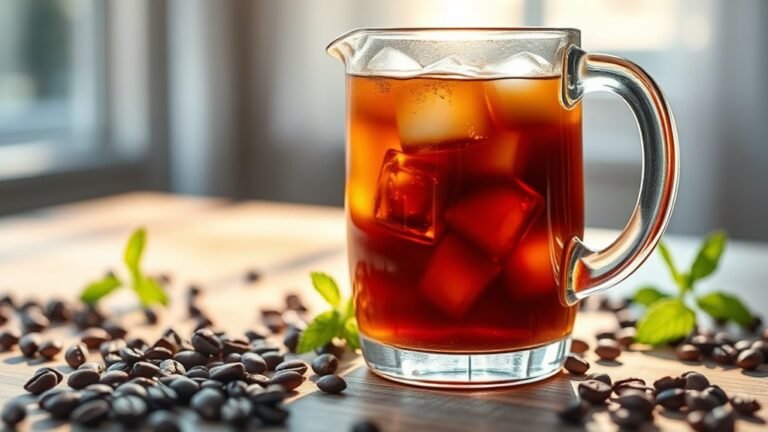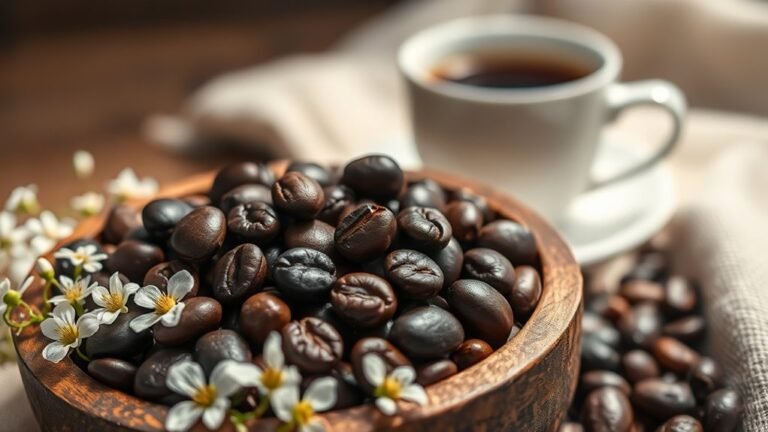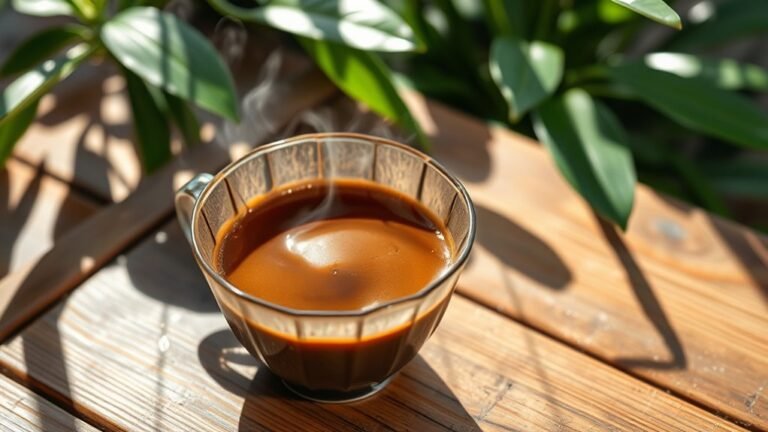The Best Coffee for French Press
For the best French Press coffee, choose freshly roasted Arabica beans with a coarse, uniform grind to avoid bitterness and sediment. Your roast level matters—dark roasts yield bold, smoky brews, while medium roasts offer balanced, full-bodied flavors; light roasts highlight bright, complex notes but need careful brewing. Origin also influences taste: Ethiopian beans provide floral brightness, Colombian ones bring smooth nuttiness. Freshness is key, so grind just before brewing. Exploring these elements will deepen your appreciation of French Press coffee.
Understanding the French Press Brewing Method

Although it might seem straightforward, mastering the French Press brewing method requires understanding its unique immersion process, where coffee grounds steep directly in hot water, allowing you to control extraction time and achieve a rich, full-bodied flavor. You’ll want to pay close attention to brewing temperature—ideally between 195°F and 205°F—to avoid bitterness or under-extraction. Water quality is just as vital; using filtered or spring water guarantees that impurities don’t mask your coffee’s true character. Since the grounds remain in contact with the water throughout brewing, you have freedom to adjust steeping duration, tailoring strength and flavor to your preference. This hands-on approach demands precision but rewards you with a robust, nuanced cup that reflects both your technique and the coffee’s inherent qualities.
Ideal Coffee Grind Size for French Press
The grind size you choose plays a fundamental role in the quality of your French Press brew. Opting for a coarse grind is essential—it allows water to flow evenly, preventing over-extraction and bitterness. You’ll want a grind consistency that’s uniform; uneven particles can lead to muddled flavors and excessive sediment. Achieving the perfect coarse grind frees you to savor a clean, rich cup every time.
Here’s what makes the ideal grind size significant:
- Coarse grind preserves bold flavors while avoiding bitterness.
- Consistent particle size guarantees balanced extraction.
- Proper grind size minimizes sediment, enhancing clarity.
Best Coffee Roast Levels for French Press
When you’re choosing the best coffee roast level for your French Press, understanding how roast profiles influence flavor extraction is essential. Dark roast beans offer bold, robust flavors and tend to extract quickly, making them ideal if you prefer strong, smoky notes. Light roast beans retain more origin characteristics and acidity, providing brighter and more complex flavors, but require precise brewing time to avoid under-extraction.
| Roast Level | Flavor Profile |
|---|---|
| Light Roast | Bright, acidic, complex |
| Medium Roast | Balanced, full-bodied |
| Dark Roast | Bold, smoky, intense |
Top Coffee Bean Origins for French Press

Since the origin of your coffee beans greatly impacts the flavor profile, choosing beans from regions known for their distinctive characteristics can elevate your French Press experience. When selecting between Arabica vs. Robusta, Arabica beans typically offer nuanced, complex flavors perfect for French Press’s full-bodied brew. Opting for single origin beans lets you savor unique regional notes, while blends provide balanced, versatile profiles.
Choosing beans by origin and type shapes the rich, complex flavors ideal for your French Press brew.
Consider these top coffee bean origins:
- Ethiopian beans: Floral and fruity, ideal if you crave bright, vibrant coffee
- Colombian beans: Balanced with nutty undertones, great for smooth, rich cups
- Indonesian beans: Earthy and bold, perfect if you prefer deep, intense flavors
Choosing the right origin lets you break free from bland coffee and enjoy a customized French Press ritual.
How Freshness Affects French Press Coffee
You’ll notice that bean freshness plays an essential role in extracting the full flavor potential of your French press coffee. Using coffee roasted within the past two weeks preserves the nuanced aroma and balanced acidity you want. For the finest results, grind your beans just before brewing to maintain ideal flavor and prevent staleness.
Importance of Bean Freshness
Freshness plays a crucial role in releasing the full potential of your French press coffee. When your beans are fresh, you reveal peak flavor extraction during brewing techniques that highlight the coffee’s natural nuances. Stale beans, on the other hand, limit this process and leave your cup flat or dull.
You’ll notice the difference when you:
- Grind fresh beans just before brewing, preserving essential oils and aromatics
- Choose beans roasted within the last two weeks to maximize vibrancy
- Store beans properly in airtight containers away from light and heat to maintain freshness
Effects on Flavor Profile
The quality of your French press coffee depends greatly on how recently the beans were roasted and ground. Fresh beans preserve oils and volatile compounds that contribute to rich flavor complexity, making each cup vibrant and nuanced. Stale beans, by contrast, lose these essential components, resulting in flat, dull taste profiles. Because French press brewing allows more oils and sediments through, freshness directly influences the depth and balance of flavors you experience. Even with controlled brewing variables like water temperature and steep time, old beans limit your ability to extract the full spectrum of flavors. To truly savor the freedom of crafting your perfect cup, prioritize freshness—it’s the foundation for revealing dynamic, layered notes that define exceptional French press coffee.
Optimal Grind Timing
Since ground coffee begins to lose its aromatic oils and flavor compounds almost immediately after grinding, timing your grind is essential for achieving the best French press brew. When you grind just before brewing, you preserve the volatile compounds that deliver rich aroma and complex taste. Maintaining grind consistency is vital; uneven grounds can cause over-extraction or under-extraction, ruining your cup. Pair your fresh grind with the ideal brewing temperature—just off boiling, around 195-205°F—to reveal full flavor without bitterness. Embrace grinding fresh to experience:
- The freedom of crafting coffee exactly how you like it
- The vibrant, nuanced flavors that fade quickly after grinding
- A consistently smooth cup that celebrates your effort and precision
Tips for Storing Coffee Beans for French Press
Although you may be enthusiastic to use your coffee beans right away, how you store them considerably impacts the flavor and quality of your French press brew. Proper coffee storage is essential to preserve freshness and aromatic oils that define your cup’s character. Always keep beans in airtight containers to prevent exposure to oxygen, moisture, and odors that degrade quality. Choose opaque containers to block light, which accelerates staling. Store your container in a cool, dry place away from heat sources or direct sunlight. Avoid refrigeration or freezing as fluctuating temperatures cause condensation and harm the beans’ integrity. By controlling storage conditions precisely, you maintain the freedom to enjoy a rich, bold French press coffee with every brew, revealing its full potential without compromise.
Frequently Asked Questions
Can I Use Flavored Coffee Beans in a French Press?
You can definitely use flavored beans in your French press, but keep in mind they might affect the brewing techniques you typically use. Since flavored beans often have added oils or coatings, they can sometimes clog the mesh filter or alter the taste more intensely during the longer steeping process. If you’re after a unique experience, go for it, but be ready to experiment with grind size and steep time to get the balance just right.
How Does Water Temperature Affect French Press Coffee?
Imagine brewing coffee like painting a canvas; water temperature is your brushstroke. If it’s too hot, above 205°F, you risk scalding the coffee, creating bitterness. Too cool, below 195°F, and your brew lacks full flavor. The ideal temperature range for French press is 195°F to 205°F, balancing extraction perfectly. Mastering this brewing technique grants you freedom to craft rich, smooth coffee every time, tailored exactly to your taste.
What Is the Best French Press Material for Coffee Taste?
When choosing the best French press material for your coffee taste, you’ll notice stainless steel offers excellent heat retention, keeping your brew hot longer without altering flavors. Glass, on the other hand, lets you watch the brewing process and doesn’t impact taste but cools faster. If you value freedom in taste and temperature control, stainless steel gives durability and consistent warmth, while glass offers purity and visual appeal. Your choice depends on what experience you want.
Can I Reuse Coffee Grounds in a French Press?
Reusing coffee grounds in your French press is like trying to relive the sunrise’s first glow—it’s possible but fades quickly. Each brew extracts coffee strength and flavor extraction peaks initially; a second steep often results in a weaker, more bitter cup. If you value boldness and freedom in your coffee ritual, fresh grounds are your best ally. For a more adventurous approach, you might experiment, but expect diminished richness and a subtler profile.
How Long Should I Let Coffee Steep in a French Press?
You’ll want to let your coffee steep in the French press for about 4 minutes to balance flavor and strength. Steeping time directly impacts coffee strength—shorter times yield lighter brews, longer times make it stronger but risk bitterness. Feel free to experiment around 3 to 5 minutes to match your taste. Just avoid over-steeping, which can overpower flavor and make your coffee too harsh for a smooth, enjoyable cup.






